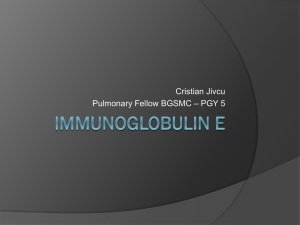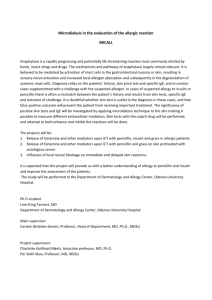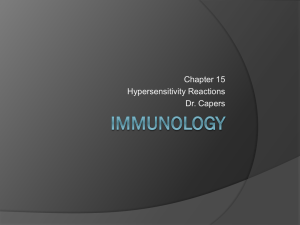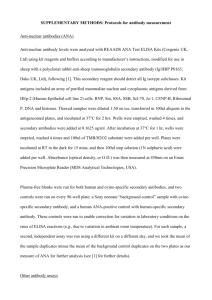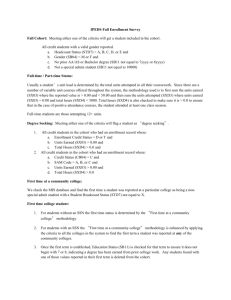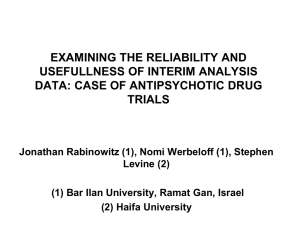Outline of B2334 primary manuscript
advertisement
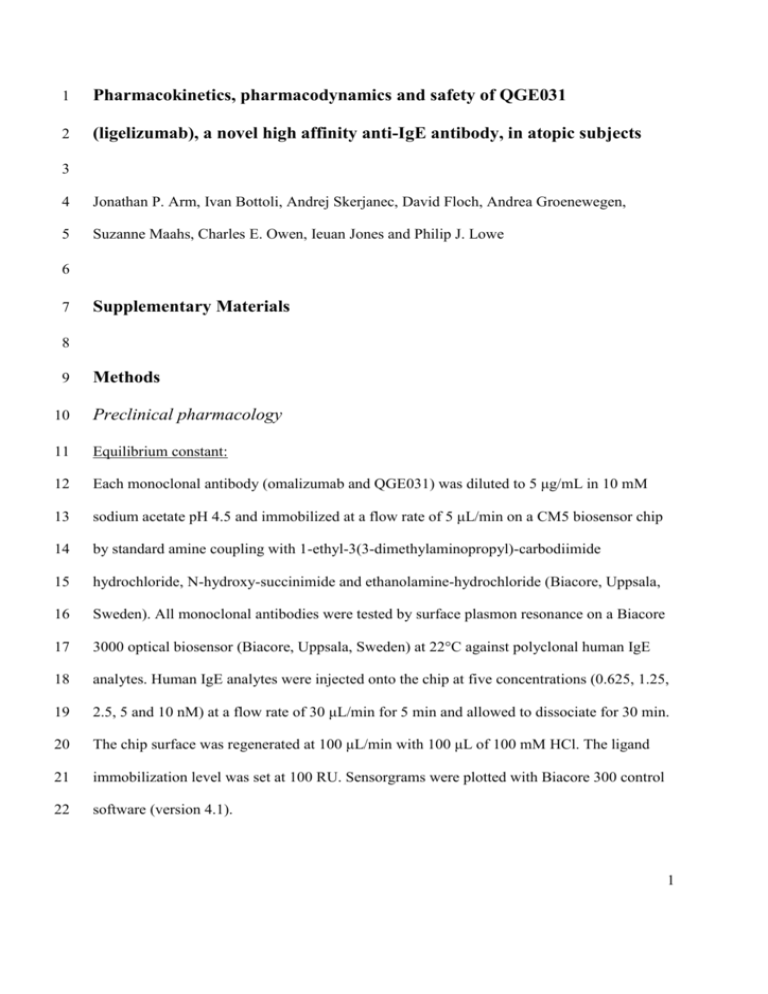
1 Pharmacokinetics, pharmacodynamics and safety of QGE031 2 (ligelizumab), a novel high affinity anti-IgE antibody, in atopic subjects 3 4 Jonathan P. Arm, Ivan Bottoli, Andrej Skerjanec, David Floch, Andrea Groenewegen, 5 Suzanne Maahs, Charles E. Owen, Ieuan Jones and Philip J. Lowe 6 7 Supplementary Materials 8 9 Methods 10 Preclinical pharmacology 11 Equilibrium constant: 12 Each monoclonal antibody (omalizumab and QGE031) was diluted to 5 μg/mL in 10 mM 13 sodium acetate pH 4.5 and immobilized at a flow rate of 5 μL/min on a CM5 biosensor chip 14 by standard amine coupling with 1-ethyl-3(3-dimethylaminopropyl)-carbodiimide 15 hydrochloride, N-hydroxy-succinimide and ethanolamine-hydrochloride (Biacore, Uppsala, 16 Sweden). All monoclonal antibodies were tested by surface plasmon resonance on a Biacore 17 3000 optical biosensor (Biacore, Uppsala, Sweden) at 22°C against polyclonal human IgE 18 analytes. Human IgE analytes were injected onto the chip at five concentrations (0.625, 1.25, 19 2.5, 5 and 10 nM) at a flow rate of 30 μL/min for 5 min and allowed to dissociate for 30 min. 20 The chip surface was regenerated at 100 μL/min with 100 μL of 100 mM HCl. The ligand 21 immobilization level was set at 100 RU. Sensorgrams were plotted with Biacore 300 control 22 software (version 4.1). 1 1 2 Inhibition of IgE binding to cell-surface FcεRI and the immobilized α-subunit of FcεRI: 3 A predetermined amount of biotinylated human IgE was mixed with serially diluted 4 monoclonal antibodies (QGE031 and omalizumab) and added to RBL-2H3 (a gift from Dr F. 5 Kricek, Novartis Dermatology, Vienna, Austria) cells expressing the α-subunit of the human 6 FcεRI receptor on their cell surface. After washing, bound IgE was detected using FITC- 7 conjugated streptavidin and mean fluorescence intensity was determined. 8 9 Serially diluted monoclonal antibodies (QGE031 and omalizumab) were loaded onto an ELISA plate coated with 1 μg/mL recombinant soluble human FcεRIα receptor. IgE 10 (200 ng/mL) was added to the plate and allowed to bind for 1 h at room temperature, thus 11 allowing IgE the opportunity to bind either with the monoclonal antibodies or the receptor. 12 The plates were washed, and IgE bound to the receptor was determined by a horseradish 13 peroxidase-labeled murine anti-human IgE monoclonal antibody, E10-10 (Tanox Inc, 14 Houston, TX, USA). 15 16 Mast cell degranulation and activation assays: 17 Human cord blood-derived mast cells at a concentration of 1 x 105 cells/80 μL in culture 18 medium supplemented with 25 ng/mL recombinant IL-4 were added to wells of 96-well V- 19 bottom plates. Ten μL aliquots of serial dilutions of monoclonal anti-IgE antibodies 20 (omalizumab, QGE031) or an isotype-matched control IgG1 monoclonal antibody were added 21 to the cells, followed by JW8 3-nitro-4-hydroxy-iodophenyl acetic acid (NIP)-specific IgE to 22 a concentration of 1 nM and incubated overnight. Cells were then spun, washed once with 23 200 μL of culture medium and resuspended in 90 μL of the assay medium. Ten μL of the 24 stimulus (100 ng/mL of NIP-BSA conjugated hapten antigen) or 10 μL of assay medium was 2 1 added and the plates were incubated for 2 h at 37°C. The plates were then spun. Cell pellets 2 from three replicates were combined and stained with anti-CD63-PE monoclonal antibody 3 (Immunotech) to determine the expression of CD63 at the cell surface by flow cytometry. β- 4 hexosaminidase release was measured as described previously [1]. 5 6 Binding activity of QGE031 across mammalian species: 7 Binding activity of QGE031 against IgE from different mammalian species was investigated 8 using ELISA measured by absorbance at 450 nm for rat (Zymed), cat (Heska), dog (Heska), 9 and human (Biodesign), while QGE031 binding to cynomolgus non-human primate was 10 11 assessed by Biacore 3000. Immulon II U-bottom 96-well plates were coated with 50 μL/well of 1μg/mL of 12 polyclonal human IgE, mouse IgE, cat IgE, rat IgE and dog IgE overnight at 4°C. Coating 13 solutions were removed and the plate blocked with 3% bovine serum albumin in phosphate 14 buffered saline (200 μL/well) for 1 h at room temperature. After washing the plates five 15 times, 50 μL/well of primary antibodies or control antibody were added and incubated for 1 h 16 at room temperature, followed by a further five washes. Goat anti-human IgG Fc-horseradish 17 peroxidase (1:2000) was added, incubated for 1 h at room temperature and the plates were 18 washed a further five times. Fifty μL of TMB substrate (3,3/, 5, 5/-tetramethyl-benzidine 19 liquid substrate system) was added to develop the reaction. Fifty μL of 0.2 M sulfuric acid 20 was added to stop the reaction, and the plate was read in a ELISA plate reader at an optical 21 density 450/570 nm. 22 Monoclonal antibodies (omalizumab and QGE031, both at 5 μg/mL) in 10 mM 23 sodium acetate (pH 4.5) were immobilized at a flow rate of 5 μL/min on a CM5 biosensor 24 chip by standard amine coupling with 1-ethyl-3(3-dimethylaminopropyl)-carbodiimide 3 1 hydrochloride, N-hydroxy-succinimide and ethanolamine hydrochloride. Different 2 concentrations of the IgE analytes from three species (human, cynomolgus monkey and 3 rhesus monkey) were injected onto the chip at a flow rate of 30 μL/min over 3–5 min and 4 allowed to dissociate for 30 min. The chip surface was regenerated at 100 μL/min with 100 5 μL 100 nM hydrochloric acid. A reference flow cell (phosphate buffered saline) was also 6 prepared. A blank (phosphate buffered saline) was injected under the same conditions as the 7 IgE analytes. Biacore software was used to determine the cross-species binding. 8 9 Methods 10 Clinical trials 11 Dose selection: 12 The intravenous study was the first-in-human study and was therefore conducted without 13 prior information of the pharmacokinetics or pharmacodynamics of QGE031 in humans. The 14 starting dose of 0.1 mg/kg was chosen based on several factors. Firstly, the 12-fold difference 15 in dissociation constant from non-human primates where doses up to 120 mg/kg were given 16 allowed for a possible starting dose of 10 mg/kg. A standard safety factor of 10-fold when 17 extrapolating from animals to man reduced the starting dose to 1 mg/kg. Finally, when 18 comparing the in vitro suppression of free IgE by QGE031 with that of an anti-IgE of similar 19 affinity, HAE-1 [2], the dose of QGE031 that would provide a similar suppression was 20 estimated to be 10-fold lower, allowing a starting dose of 0.1 mg/kg. As this was a first-in- 21 human study, the first two subjects in Cohort 1 were dosed on consecutive days in an open- 22 label manner. The remaining subjects in Cohort 1 were dosed in a double-blind manner. For 23 subsequent Cohorts (2–6), subjects were dosed in a double-blind manner with at least 2 h 24 separating the dosing of each subject. 4 1 The highest dose of QGE031 for the subcutaneous study was based upon model-based 2 pharmacokinetics simulations that predicted an adequate exposure margin compared with 3 exposure to non-human primates in preclinical safety studies 4 Institutional Review Boards: 5 There was one Institutional Review Board (IRB) for the intravenous study (Aspire IRB, CA, 6 USA) and three IRBs for the subcutaneous study (Aspire IRB, CA, USA; Quorum Review 7 Inc, WA, USA and Alpha IRB, CA, USA). 8 9 Protocol amendments: 10 Intravenous trial 11 The study protocol was amended five times, and most amendments included administrative 12 and personnel changes. None of the amendments were considered to have affected the 13 interpretation of study results as they occurred prior to unblinding. Of the five amendments, 14 the most significant was the introduction of the placebo expansion group (Cohort 6a); 15 Amendment 5, 13 November 2009. 16 17 Subcutaneous trial 18 The protocol was amended once after a planned interim analysis that revealed no urticarial 19 events in at least 36 subjects who had received four doses of QGE031 (Amendment 1, 02 20 February 2011). The amendment included an additional cohort of subjects who were to 21 receive a higher dose of QGE031 (Cohort 6) to further explore the safety, tolerability, 22 pharmacokinetics and pharmacodynamics of QGE031 to facilitate dose selection for 23 subsequent Phase II studies. The amendment also modified the visit schedule of subjects who 24 received 4-weekly doses of omalizumab. The original version of the protocol assumed 5 1 biweekly dosing of omalizumab. However, several subjects were dosed monthly in 2 accordance with the established dosing table [3] and the modified visit schedule streamlined 3 visits and assessments on non-dosing days. The amendment allowed inclusion of subjects 4 with atopic dermatitis to facilitate recruitment of subjects with IgE > 700 IU/mL. 5 6 Pharmacokinetic measurement of QGE031 in serum: 7 One hundred microliters of 2 μg/mL biotin conjugated mouse-anti-human-IgE antibody (BD 8 Pharmingen No. 555858, Batch 07164, 0.5 mg/mL) was coated onto each well of 9 streptavidin-precoated 96-well microplates (F96, No. 436014, Nunc). The plates were placed 10 on a microplate shaker (Titramax 1000, Heidolph, Merck) and incubated in the dark at room 11 temperature for 1 h. The plates were then washed three times with 300 μL/well of wash 12 buffer (Tris Buffered Saline with Tween-20® pH 8.0, No. T-9039, Sigma). Ten microliters of 13 standard samples, unknowns and quality controls were added to 475 μL of sample dilution 14 buffer (Low Cross Buffer, Pierce), together with 25 μL of 100 μg/mL of human-IgE solution 15 (Myeloma Biodesign, A50796H, batch 1E14405, 1.199 mg/mL). After shaking for 30 min at 16 room temperature, 100 μL was added to each well. The plates were placed on the microplate 17 shaker and incubated for 2 h in the dark at room temperature. 18 The plates were washed four times with wash buffer to remove any unbound 19 substance. One hundred microliters of an alkaline phosphatase-linked mouse monoclonal 20 antibody specific for human IgG (1:10000 dilution of 1.8 mg/mL, No. A2064, Lot 21 077K4793, Clone CG-5, Sigma) was added to bind to the captured QGE031, and the plate 22 was again incubated (shaking) for 1 h in the dark at room temperature. After three additional 23 washing steps to remove unbound reagent, 100 μL of substrate solution (No. UP664791, 24 Uptima) was added and incubated for 50 min (shaking) in the dark at room temperature. The 6 1 plates were read using a Vmax Microplate reader (Molecular Devices) at 405 nm using 2 SoftMax Pro (version 5.0.1) software. 3 4 Pharmacodynamic assessments - total IgE: 5 One hundred microliters of 0.5 μg/mL biotin conjugated goat-anti-human-IgE antibody (Ref. 6 A80-108A, Bethyl) was coated onto each well of streptavidin-precoated 96-well microplates 7 (F96, No. 436014, Nunc) and placed on a microplate shaker (Titramax 1000, Heidolph, 8 Merck) and incubated in the dark at room temperature for 1 h. The plates were then washed 9 three times with 300 μL/well of wash buffer (Tris Buffered Saline with Tween-20® pH 8.0, 10 No. T-9039, Sigma). One hundred microliters of standard samples, unknowns and quality 11 controls were added to 100 μL of a solution of QGE031 (300 μg/mL) and shaken for 30 min 12 at room temperature to complex all the IgE in the sample. The complexes were then further 13 diluted 1:10 with Low Cross Buffer (Pierce) and 100 μL added to each well followed by 14 incubation (shaking) for 2 h at room temperature in order to capture the complex with the 15 coated goat-anti-IgE antibody. 16 The plates were washed three times with wash buffer to remove any unbound 17 substance. One hundred microliters of an alkaline phosphatase-linked mouse monoclonal 18 antibody specific for human IgG (1:10000 dilution of 1.8 mg/mL, No. A2064, Lot 19 077K4793, Clone CG-5, Sigma) was added to bind to the captured QGE031 and the plate 20 was again incubated (shaking) for 1 h in the dark at room temperature. After three additional 21 washing steps to remove unbound reagent, 150 μL of substrate solution (No. UP664791, 22 Uptima) was added and incubated for 60 min (shaking) in the dark at 37°C. Optical density 23 was measured using a Vmax microplate reader (Molecular Devices) at 405 nm and using 24 SoftMax Pro (version 5.0.1) software. 7 1 2 Pharmacodynamic assessments - free IgE: 3 One hundred microliters of IgE high-affinity receptor (FcεRI conjugated, 1.5 μg/mL, 4 Novartis Pharma AG) was added to each well of 96-wells microplates (MaxiSorp plates, No. 5 439454, Nunc) and incubated over night at 4°C. The plates were then washed four times with 6 300 μL/well of wash buffer (Tris Buffered Saline with Tween-20® pH 8.0, No. T-9039, 7 Sigma). Three hundred microliters of Superblock Blocking Buffer (No. 37535, Pierce) was 8 added to each well and the plate was placed on a microplate shaker (Titramax 1000, 9 Heidolph, Merck) and incubated for 20 min at room temperature. The plates were then 10 washed a further four times with wash buffer. Each standard sample, unknowns and quality 11 controls were diluted 1:5 (Low Cross Buffer, Pierce) and 100 μL of diluted sample was added 12 to each well and incubated for 2 h (shaking) at room temperature in the dark. 13 The plates were washed four times with wash buffer to remove any unbound 14 substance. One hundred microliters of an alkaline phosphatase-linked mouse monoclonal 15 antibody specific for human IgE (No. 555859, BD) was added and the plate was again 16 incubated (shaking) for 1 h in the dark at room temperature. After six washing steps to 17 remove unbound reagent, 50 μL of substrate solution NADPH was added to each well and 18 incubated for 15 min (shaking) at room temperature. Finally, 50 μL of Amplifier solution 19 (No. 19589-019, Invitrogen) was added to each well and then incubated (shaking) for 20 min 20 at room temperature. Fifty microliters of Stop solution (Sulfuric acid) was added to terminate 21 the reaction. Optical density was measured using a VersaMax microplate reader (Molecular 22 Devices) at 495 nm using SoftMax Pro (Version 5.0.1) software. 23 24 8 1 Pharmacodynamic assessments: fluorescence-activated cell sorting analysis: 2 Antibodies and reagents 3 Basophil selection: Mouse anti-human Lineage cocktail-FITC, monoclonal antibody cocktail- 4 FITC (BD 340546), Mouse anti-Human CD203c-PerCp-Cy5.5 monoclonal antibody 5 (BioLegend 324608). For the expression levels of FcεRI and IgE: Mouse monoclonal anti- 6 Human FcεRI-APC (eBioscience 17-5699), mouse monoclonal anti-human IgE-PE 7 (BioLegend 325506). 8 9 Protocol 10 At the clinical site antibody mixes were added to 200 µL aliquots of whole blood and 11 incubated for 30 min at room temperature. Lyse/fix buffer (BD 349202) was then added and 12 the samples frozen at -80°C and sent to the fluorescence-activated cell sorting analysis 13 laboratory (Cellular Biomarker Group, Novartis Institutes for Biomedical Research, Basel, 14 Switzerland). After thawing and antibody-staining with the antibodies mentioned above, 15 2000 basophils were acquired for each sample by flow cytometry performed on a 16 fluorescence-activated cell sorting Canto II cytometer. Molecules of equivalent soluble 17 fluorochrome values were calculated using Quantum molecules of equivalent soluble 18 fluorochrome beads (Bangs Laboratories Inc.) 19 20 Pharmacokinetic and pharmacodynamic model of binding to and capture of IgE by QGE031 21 and omalizumab: 22 The pharmacokinetic profile of QGE031 and several pharmacodynamic parameters including 23 total IgE, basophil FcRI and basophil surface IgE were analyzed using an adaptation of the 24 previously published omalizumab PK-IgE binding model [4-6]. The published model was 9 1 updated to include: i) two compartments instead of one to allow the analysis of the 2 intravenous pharmacokinetics of QGE031; ii) basophil FcεRI and surface IgE as indirect 3 responses to free IgE suppression; iii) both QGE031 and omalizumab with the assumption 4 that the only difference between the compounds was their ability to bind IgE given that they 5 are both IgG1 monoclonal antibodies. Model parameters for drug clearances and volumes of 6 distribution, binding of QGE031 or omalizumab to and turnover of IgE, the effect of free IgE 7 on basophil FcRI and surface IgE were estimated to get the mathematical equations to fit the 8 clinical time course data for the pharmacokinetic and pharmacodynamic assessments. As in 9 prior publications, the NONMEM® software (Icon plc, Dublin, Ireland) was used for the 10 model based analysis. 11 12 Pharmacodynamic assessments: extinction skin prick testing (subcutaneous trial): 13 At screening, skin prick testing was performed with single doses of multiple allergens. 14 Subsequent extinction skin prick testing was performed in duplicate on the subjects’ skin of 15 the back with serial three-fold dilutions of a selected allergen that provided a > 5 mm mean 16 wheal diameter at screening. Extinction skin prick testing was performed at baseline, on Days 17 29, 57 and 85, and at the end of the study (Day 155). Wheal and flare reactions were outlined 18 by pen and transferred by tape to a permanent record; the mean of the longest diameter and 19 corresponding midpoint orthogonal diameter were recorded. Only the flares were measured 20 for subjects in Cohort 1, which was a protocol deviation. Data from one site were excluded 21 due to poor duplicates and lack of a dose-response curve. Data from two subjects at Day 85 22 were excluded from the analyses due to protocol deviations (administration of antihistamines 23 prior to skin prick testing). These decisions were taken prior to database lock and unblinding 24 of the trial. 10 1 2 Statistical methods - skin prick data: 3 Arithmetic means of the skin prick test wheal and flare diameters were calculated from the 4 longest measurement and its orthogonal diameter, performed in duplicate. A positive 5 response for each dilution was defined where the mean diameter was at least 3 mm greater 6 than the mean diameter for the negative control. The threshold (i.e., the maximum dilution 7 level eliciting a positive wheal and flare response) was derived for each subject. Values were 8 assigned according to the dilution level (i.e., a value of 1 for the first dilution, 1:3, a value of 9 2 for the second dilution, and so on to a highest value of 10 for a dilution of 1:59,049). If a 10 response was seen with neat allergen the maximum dilution was assigned a value of 0. If no 11 positive skin prick test occurred the maximum dilution level was assigned a value of -1. 12 . 11 1 References 2 1 Nechansky A, Robertson MW, Albrecht BA, Apgar JR, Kricek F. Inhibition of antigen- 3 induced mediator release from IgE-sensitized cells by a monoclonal anti-Fc epsilon RI 4 alpha-chain receptor antibody: implications for the involvement of the membrane- 5 proximal alpha-chain region in Fc epsilon RI-mediated cell activation. J Immunol 2001; 6 166:5979–90. 7 2 Putnam WS, Li J, Haggstrom J et al. Use of quantitative pharmacology in the 8 development of HAE1, a high-affinity anti-IgE monoclonal antibody. AAPS J 2008; 9 10:425–30. 10 11 12 3 Genentech. Xolair: US prescribing information. Updated July 2010. Last accessed 15 February 2014. http://www.gene.com/download/pdf/xolair_prescribing.pdf 4 Hayashi N, Tsukamoto Y, Sallas WM, Lowe PJ. A mechanism-based binding model for 13 the population pharmacokinetics and pharmacodynamics of omalizumab. Br J Clin 14 Pharmacol 2007; 63:548–61. 15 5 Lowe PJ, Tannenbaum S, Gautier A, Jimenez P. Relationship between omalizumab 16 pharmacokinetics, IgE pharmacodynamics and symptoms in patients with severe 17 persistent allergic (IgE-mediated) asthma. Br J Clin Pharmacol 2009; 68:61–76. 18 6 Slavin RG, Ferioli C, Tannenbaum SJ, Martin C, Blogg M, Lowe PJ. Asthma symptom 19 re-emergence after omalizumab withdrawal correlates well with increasing IgE and 20 decreasing pharmacokinetic concentrations. J Allergy Clin Immunol 2009; 123:107–13. 21 22 12 Table S1. Subject demographics for treatment groups for (a) the intravenous trial and (b) the subcutaneous trial (a) Cohort 1 Cohort 2 Cohort 3 Cohort 4 Cohort 5 Cohort 6 Cohort 7 0.1 mg/kg 0.3 mg/kg 1.0 mg/kg 3.0 mg/kg 3.0 mg/kg 10 mg/kg Xolair Placebo Cohort 6a Placebo All treatments (expansion IgE group) > 1000 IU/mL n=6 n=6 n=8 n=9 n=1 n=6 n=8 n = 11 n = 18 N = 73 Mean (SD) 32.3 (11.7) 31.5 (9.4) 39.3 (10.5) 35.0 (8.3) 29.0 30.7 (9.4) 34.3 (8.6) 34.5 (12.5) 32.9 (8.7) 33.8 (9.6) Range 20, 48 22, 47 25, 50 19, 46 NC 22, 48 24, 50 18, 48 22, 51 18, 51 6 (100) 6 (100) 5 (63) 9 (100) 1 (100) 6 (100) 8 (100) 8 (73) 17 (94) 66 (90) 76.1 (3.1) 69.7 (12.5) 81.2 (15.1) 81.4 (13.0) 77.9 80.8 (7.5) 81.4 (10.2) 75.6 (14.2) 78.6 (10.8) 78.3 (11.5) Age (years) Gender Male, n (%) Weight (kg) Mean (SD) 13 Range 72.9, 80.1 60.0, 87.5 Mean (SD) 173.2 (6.9) Range 56.6, 99.4 59.7, 99.8 NC 71.3, 92.0 68.6, 100.0 58.0, 99.2 50.4, 93.5 50.4, 100.0 172.7 (10.8) 170.6 (12.8) 176.1 (5.4) 182 175.8 (6.2) 175.5 (4.7) 173.4 (6.8) 173.1 (7.6) 173.8 (7.7) 166, 185 159, 189 154, 193 169, 187 NC 166, 184 170, 182 159, 181 160, 187 154, 193 Caucasian 4 (67) 3 (50) 5 (63) 6 (67) 0 5 (83) 6 (75) 6 (55) 11 (61) 46 (63) Black 2 (33) 3 (50) 3 (38) 3 (33) 1 (100) 0 2 (25) 3 (27) 1 (6) 18 (25) Asian 0 0 0 0 0 1 (16.7) 0 1 (9.1) 5 (27.8) 7 (9.6) Other 0 0 0 0 0 0 0 1 (9.1) 1 (5.6) 2 (2.7) Height (cm) Race, n (%) SD, standard deviation. 14 (b) Cohort 1 Cohort 2 Cohort 3 Cohort 4 Cohort 5 Cohort 6 and 6 pooled IgE > 700 IU/mL 0.2 mg/kg Placebo 0.6mg/kg 2 mg/kg 2 mg/kg Placebo Cohorts 2, 3 Omalizuma 4 mg/kg placebo* b n=8 n=4 n=8 n = 40 n=6 n=6 n = 12 n=8 n = 18 Mean (SD) 39 (10.2) 41 (12.0) 28 (9.7) 33 (9.4) 33 (7.5) 32 (11.8) 33 (10.3) 37 (11.5) 35 (11.4) Range 23, 49 24, 52 20, 49 19, 53 26, 43 19, 48 20, 55 25, 53 19, 55 4 (50) 4 (100) 7 (88) 35 (88) 5 (83) 5 (83) 10 (83) 7 (88) 15 (83) Mean (SD) 81.4 (20.3) 69.2 (7.0) 76.7 (15.8) 82.1 (13.3) 91.5 (18.9) 83.3 (22.5) 86.1 (11.5) 81.8 (14.8) 80.0 (15.0) Range 61.0, 112.6 61.0, 76.5 61.7, 100.7 63.3, 114.6 68.9, 116.5 59.1, 118.4 70.2, 111.0 64.0, 106.4 49.1, 103.5 Age (years) Gender Male, n (%) Weight (kg) Height (cm) 15 Mean (SD) 171 (9.5) 170 (7.0) 179 (9.6) 176 (7.3) 177 (4.3) 170 (4.5) 175 (7.8) 174 (8.7) 173 (11.6) Range 156, 188 161, 177 166, 195 163, 195 169, 181 165, 178 163, 187 160, 186 151, 192 Caucasian 5 (63) 3 (75) 5 (63) 25 (63) 3 (50) 4 (67) 8 (67) 6 (75) 12 (67) Black 2 (25) 1 (25) 3 (38) 12 (30) 3 (50) 1 (17) 4 (33) 1 (13) 4 (22) Asian 0 0 0 1 (3) 0 1 (17) 0 1 (13) 1 (6) Other 1 (13) 0 0 2 (5) 0 0 0 0 1 (6) Race, n (%) *Pooled over Cohorts 2, 3 and 6. SD, standard deviation. 16 Table S2. Statistical analysis of the wheal area under the curve from the skin prick testing in the subcutaneous study N* LS mean Difference 95% CI P-value compared with placebo Day 29 Cohort 2 (0.6 mg/kg) 4 19.3 -9.8 -20.1, 0.5 0.063 Cohort 3 (2 mg/kg) 29 15.1 -14.0 -19.7, -8.3 < 0.001 Cohort 6 (4 mg/kg) 7 18.4 -10.7 -19.1, -2.3 0.013 Cohorts 2, 3 and 6 (pooled placebo) 16 29.1 Cohort 4 (2 mg/kg IgE > 700 IU/mL) 5 13.5 -23.6 -35.8, -11.4 < 0.001 Cohort 4 (placebo IgE > 700 IU/mL) 4 37.1 Cohort 2 (0.6 mg/kg) 4 13.2 -21.1 -33.6, -8.5 0.001 Cohort 3 (2 mg/kg) 27 8.0 -26.3 -33.3, -19.3 < 0.001 Cohort 6 (4 mg/kg) 7 11.8 -22.5 -32.7, -12.3 < 0.001 Cohorts 2, 3 and 6 (pooled placebo) 16 34.3 Cohort 4 (2 mg/kg IgE > 700 IU/mL) 4 -0.1 -38.8 -55.9, -21.8 < 0.001 Cohort 4 (placebo IgE > 700 IU/mL) 3 38.8 Cohort 2 (0.6 mg/kg) 4 14.9 -19.6 -34.6, -4.5 0.012 Cohort 3 (2 mg/kg) 26 0.4 -34.1 -42.7, -25.4 < 0.001 Cohort 6 (4 mg/kg) 7 4.7 -29.7 -41.9, -17.6 < 0.001 Cohorts 2, 3 and 6 (pooled placebo) 14 34.4 Cohort 4 (2 mg/kg IgE > 700 IU/mL) 5 9.1 -31.8 -50.8, -12.9 0.001 Day 57 Day 85 17 Cohort 4 (placebo IgE > 700 IU/mL) 3 40.9 Cohort 2 (0.6 mg/kg) 4 52.1 10.7 -17.5, 38.9 0.45 Cohort 3 (2 mg/kg) 31 17.5 -23.8 -39.3, -8.4 0.003 Cohort 6 (4 mg/kg) 8 22.1 -19.2 -41.3, 2.8 0.086 Cohorts 2, 3 and 6 (pooled placebo) 16 41.3 Cohort 4 (2 mg/kg IgE > 700 IU/mL) 5 32.1 -7.7 -41.3, 26.0 0.65 Cohort 4 (placebo IgE > 700 IU/mL) 4 39.8 Day 155 (end of study) *Analysis included only those subjects who had a value at both baseline and post-dose. LS, least-squares; CI, confidence interval. 18 Figure legends Fig. S1. Overview of the pharmacokinetics of QGE031 and pharmacodynamic responses to QGE031, omalizumab or placebo for total and free IgE, basophil FcεRI and surface IgE, skin prick test wheal and flare responses. Red lines indicate patients with IgE screening levels > 1000 IU/mL (3 mg/kg) or > 700 IU/mL (placebo, 2 mg/kg QGE031). For comparative puprposes across studies, placebo and omalizumab groups contain subjects pooled from both trials. Data presented are individual subject responses. iv, intravenous; MESF, molecules of equivalent soluble fluorochrome; s, soluble; sc, subcutaneous. Fig. S2. Percentage of subjects treated with QGE031 (0.6, 2, 4 mg/kg), omalizumab and placebo with positive wheal responses by dilution level following skin-prick challenge. 19
